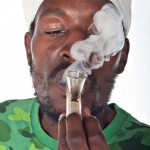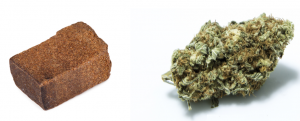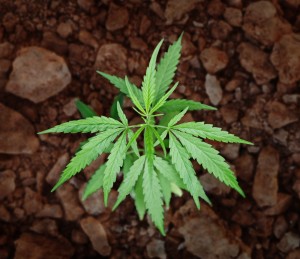By Suzi Gage @soozaphone
This blog originally appeared on the Mental Elf site on 11th May 2016.
The use of recreational drugs is seen at much higher rates in populations with mental health problems than in the general population, and this is true for both legal substances such as alcohol and tobacco, as well as prohibited substances like cannabis.
But understanding what these associations mean is problematic:
- Do the substances cause psychiatric problems?
- Do people use recreational drugs to self-medicate?
- Or, is there some other factor earlier in life that can lead to both risk of substance use and mental health problems?
The impact of cannabis (Hamilton, 2016) on mental health (Kennedy, 2015) is of particular interest in the USA, where cannabis is now legal in some states, and decriminalized in a number of others. There is a fear that cannabis use will increase, and therefore there is a pressing need to understand the nature of its association with psychiatric problems.
Blanco and colleagues state that this is their particular motivation for undertaking the research they have just published, to try and understand whether cannabis use predicts later substance use disorders, and also mood and anxiety disorders.
Methods
This study used a very large sample of adults in the USA, measured at 2 time-points, 3 years apart. Cannabis use in the past year was assessed at wave one, and a variety of outcomes were assessed at wave 2. These were cannabis use disorder, alcohol use disorder, nicotine dependence, other drug use disorder, mood disorder (including depressive disorder, bipolar I or II and dysthymia), and anxiety disorder (including panic disorder, social anxiety disorder, specific phobia, and generalized anxiety disorder). These were all assessed using the Alcohol Use Disorder and Associated Disabilities Interview Schedule DSM-IV.
Regression analyses were used to look at the associations between cannabis and these disorders, before and after adjustment for a variety of other factors that might influence both cannabis use and mental health, and therefore could be confounding the relationship. These were socio-demographic characteristics, family history of substance use disorder, disturbed family environment, childhood parental loss, low self-esteem, social deviance, education, recent trauma, past and present psychiatric disorder, past substance use disorder and history of divorce.
The authors also used propensity score matching to try and further account for these confounders. This is a technique where cannabis users and non-users are matched by their values for the confounding variables, then compared. If confounding is the same between cannabis users and non-users, it cannot therefore drive the associations seen, meaning they’re more likely to be causal, rather than due to other factors (although confounding has to have been known about and measured for this to be the case). The sample size is a lot smaller for these analyses, with 1,254 people in each group.

Cannabis is now legal in some US states, so evidence about it’s potential risks is even more in demand.
Results
Of the 34,653 participants in the study, only 1,279 (roughly 3.5%) reported having used cannabis in the past 12 months at wave one. Before taking confounders in to consideration, cannabis use at wave one was associated with substance use disorders and mood and anxiety disorders. However, this changed after accounting for the factors the authors believed might confound the relationships.
Across the regressions and the propensity matched analyses, adjustment for confounders attenuated the associations between cannabis use and later mood and anxiety disorders, suggesting that these might be due to confounding. Conversely, associations remained between cannabis use and later substance abuse and dependence. This was particularly strong for cannabis abuse, as might be expected.
- Cannabis use at wave one was associated with around a 7x increased risk of cannabis abuse or dependence at wave 2
- Cannabis users also had 2-3x increased risk of alcohol use disorder or any other drug use disorder
- Cannabis users also had around 1.5x increased risk of nicotine dependence.

Cannabis use was found to increase the risk of various substance use disorders.
Conclusions
The study found evidence that cannabis use predicts substance use disorder, even after adjustment for confounding. However, they also found that associations between cannabis use and later mood and anxiety disorders seemed to be due to confounding, rather than there being a causal association.
The authors concluded:
These adverse psychiatric outcomes [substance use disorders] should be taken under careful consideration in clinical care and policy planning.

After confounders had been taken into account, cannabis use was not found to increase the risk of mood or anxiety problems.
Strengths and limitations
A strength of this study is the use of a nationwide sample, assessed at two different time points, and that they had a really big sample size. The authors also took steps to try and keep the sample representative, even after drop-out between wave one and wave two. The consideration of confounders is also a strength, although of course causation cannot be ascertained from observational data; a limitation that the authors themselves acknowledge.
When studies are very large, as this one is, it can be hard to get really accurate measures, because of the amount of time it takes to interview 35,000 people! It is particularly impressive that the outcome measures are all according to DSM-IV criteria. However, as all these measures were taken from an Alcohol Use Disorder interview, the measures of mood and anxiety may be less good (the interview has weaker test-retest reliability for mood and anxiety disorders than for substance use disorders).
The rate of cannabis use in this study (roughly 3.5%) seems very low; the UN’s World Drug Report in 2011 (UNODC, 2011) put previous-year cannabis use in the USA at 13.7%. The data used in the Blanco study were collected in 2001, so perhaps cannabis rates have increased since then. It is notoriously hard to monitor rates of illicit drug use as people may not be keen to honestly report their use; indeed, this may be a problem in this study too, meaning people might be misclassified.
The use of other substances at wave one isn’t necessarily adequately controlled for; pre-existing substance use disorders are controlled for, but less extreme use of a substance isn’t. So these participants that are using cannabis might also be smoking cigarettes, drinking alcohol, or using other illicit drugs. There’s no way to know from this study which came first, and this makes it difficult to know whether cannabis is causing the associations seen, or whether it could be another substance, for example.
While the use of propensity score matching is perhaps a stronger method to assess causation than simply adjusting for confounders, the technique cannot take in to account confounders that vary over time, as these could vary differently between cannabis users and non-users, and still be confounding the association despite being the same at one time point.
Although the authors rightly highlight that associations of cannabis use with later substance use disorders are robust to confounding, their conclusions don’t highlight that adjustment actually reduced the association between cannabis use and later mood and anxiety disorders to the null. I think this is a really interesting finding, and maybe should have been made more of.

Why did the authors not make more of their finding that cannabis use does not increase the risk of depression or anxiety?
Summary
This is a well designed study on a really large sample, and provides useful information about associations between cannabis use and later substance use disorders, as well as suggesting that perhaps associations between cannabis use and mood and anxiety disorders might be due to other factors, rather than due to cannabis causing these outcomes. It still doesn’t really tell us why cannabis use might increase the risk of substance use disorders, and doesn’t tell us that cannabis is causing this increase of risk.
Links
Primary paper
Blanco C, Hasin DS, Wall MM, et al. (2016) Cannabis Use and Risk of Psychiatric Disorders: Prospective Evidence From a US National Longitudinal Study. JAMA Psychiatry.Published online February 17, 2016. doi:10.1001/jamapsychiatry.2015.3229. [PubMed abstract]
Other references
Hamilton I. (2016) Cannabis: what do we know and what do we need to know? The Mental Elf, 17 Mar 2016.
Kennedy E. (2015) High potency cannabis and the risk of psychosis. The Mental Elf, 24 Mar 2015.
UNODC (United Nations Office on Drugs and Crime) (2011) UN World Drug report 2011. United Nations.
Photo credits
- Jurassic Blueberries CC BY 2.0
- Jeffrey Beall CC BY 2.0
- Heath Alseike CC BY 2.0
- Photo by Thomas CC BY 2.0
- Sarah CC BY 2.0
– See more at: http://www.nationalelfservice.net/mental-health/substance-misuse/cannabis-and-mental-illness-its-complicated/#sthash.U9604663.dpuf

 Nine months later I was on my way to Heathrow for a two month stint collecting data on a cannabis administration study. I was both excited and apprehensive. I have never lived more than a 3 hour drive away from family, and have always been in a city where I have known people. I didn’t know whether I would get homesick, or whether I would make friends on my trip abroad. These feelings of apprehension soon disappeared in the first few hours of my first day at the New York Psychiatric Institute. Everyone I met was so friendly and welcoming, even the many morning commuters who stopped to help the lone Brit who was obviously puzzled by the subway map at 7.30am.
Nine months later I was on my way to Heathrow for a two month stint collecting data on a cannabis administration study. I was both excited and apprehensive. I have never lived more than a 3 hour drive away from family, and have always been in a city where I have known people. I didn’t know whether I would get homesick, or whether I would make friends on my trip abroad. These feelings of apprehension soon disappeared in the first few hours of my first day at the New York Psychiatric Institute. Everyone I met was so friendly and welcoming, even the many morning commuters who stopped to help the lone Brit who was obviously puzzled by the subway map at 7.30am. I was to spend the next six weeks collecting data for a study examining the neuro-behavioural mechanisms of decisions to smoke cannabis at the Substance Use Research Center in the New York Psychiatric Institute at Columbia University. This research centre is unique; it is one of the largest drug administration centre in the world and has licenses to administer a wide variety of drugs, including cannabis, cocaine and heroin. This means that much of the research conducted here is cutting edge. The aim of the study that I would be working on was to shed light on how and why drug abusers repeatedly make decisions to take drugs despite substantial negative consequences. The study used brain imaging (fMRI) to examine the neural and behavioural processes involved in decisions to self-administer cannabis, compared to decisions to eat food, in regular cannabis users. We also examined the influence of drug and food cues on the processes underlying these decisions. To do this, participants were recruited as inpatients and stayed with us in the lab for a week. Data collection for this study is still ongoing, but I will be sure to write another blog post with what we found when the results are available.
I was to spend the next six weeks collecting data for a study examining the neuro-behavioural mechanisms of decisions to smoke cannabis at the Substance Use Research Center in the New York Psychiatric Institute at Columbia University. This research centre is unique; it is one of the largest drug administration centre in the world and has licenses to administer a wide variety of drugs, including cannabis, cocaine and heroin. This means that much of the research conducted here is cutting edge. The aim of the study that I would be working on was to shed light on how and why drug abusers repeatedly make decisions to take drugs despite substantial negative consequences. The study used brain imaging (fMRI) to examine the neural and behavioural processes involved in decisions to self-administer cannabis, compared to decisions to eat food, in regular cannabis users. We also examined the influence of drug and food cues on the processes underlying these decisions. To do this, participants were recruited as inpatients and stayed with us in the lab for a week. Data collection for this study is still ongoing, but I will be sure to write another blog post with what we found when the results are available. I found this research fascinating and it was a pleasure to be involved in the work carried out in this department. The experience was made even more enjoyable by the people I was working with. There were many office conversations about the British and American slang that was being used, many lunchtime trips to Chipotle (an American fast food restaurant that I am definitely missing since my return to the UK), and several Friday evening trips to the local Irish bar. One office memory that will always stick in my mind was meeting a very accomplished researcher in the field of my PhD, a researcher that was definitely someone I should be impressing. Upon entering this individuals office on an extreme
I found this research fascinating and it was a pleasure to be involved in the work carried out in this department. The experience was made even more enjoyable by the people I was working with. There were many office conversations about the British and American slang that was being used, many lunchtime trips to Chipotle (an American fast food restaurant that I am definitely missing since my return to the UK), and several Friday evening trips to the local Irish bar. One office memory that will always stick in my mind was meeting a very accomplished researcher in the field of my PhD, a researcher that was definitely someone I should be impressing. Upon entering this individuals office on an extreme I did, of course, take every opportunity to explore New York. I was lucky enough to get tickets to watch the New York Yankees beat the Boston Red Sox at the Yankee Stadium, which was also one of the last games played by baseball-legend Derek Jeter. I made several trips to the American Natural History Museum (my favourite type of museum, and this one cannot be done in a day), and while there saw a live spider show, a 3D film about Great White Sharks and a full T-Rex skeleton. The glorious weather allowed for several leisurely strolls around Central Park. And, of course, the American food definitely needs a mention. If anyone reading this takes a trip over the Atlantic, I would definitely recommend visiting Big Daddy’s Diner for what could be the best milkshake on the planet. And don’t be shy about trying a hotdog from one of the carts that can be found on nearly every street corner. The reason there are so many of them is that they’re delicious! I would also recommend a trip to the Russian Tea Rooms for caviar afternoon tea, an evening at the New York Metropolitan Opera (if that’s your cup of tea), and a trip to Coney Island.
I did, of course, take every opportunity to explore New York. I was lucky enough to get tickets to watch the New York Yankees beat the Boston Red Sox at the Yankee Stadium, which was also one of the last games played by baseball-legend Derek Jeter. I made several trips to the American Natural History Museum (my favourite type of museum, and this one cannot be done in a day), and while there saw a live spider show, a 3D film about Great White Sharks and a full T-Rex skeleton. The glorious weather allowed for several leisurely strolls around Central Park. And, of course, the American food definitely needs a mention. If anyone reading this takes a trip over the Atlantic, I would definitely recommend visiting Big Daddy’s Diner for what could be the best milkshake on the planet. And don’t be shy about trying a hotdog from one of the carts that can be found on nearly every street corner. The reason there are so many of them is that they’re delicious! I would also recommend a trip to the Russian Tea Rooms for caviar afternoon tea, an evening at the New York Metropolitan Opera (if that’s your cup of tea), and a trip to Coney Island. Although it was daunting going abroad for that length of time to begin with, I don’t think I would be having those feelings again and I would definitely jump at any opportunity to work in a different environment in the future. I am very grateful that I am a PhD student in a large working group like TARG, as without this I probably would not have come across opportunities such as this one. This experience has taught me the importance of inter-disciplinary research, and the need for several fields contributing evidence to a much larger research question. Since this trip, I have been successful in a fellowship application allowing me 9 months in a different department at the University of Bristol, an application that I probably would not have made if it wasn’t for my experience at the Columbia University. I am an epidemiologist and do not have any plans to change that; however I do plan to conduct more interdisciplinary research in the future. I would like to that Gill (and everyone in her lab group) for welcoming me and making this trip possible. I look forward to hopefully working with you again in the future…
Although it was daunting going abroad for that length of time to begin with, I don’t think I would be having those feelings again and I would definitely jump at any opportunity to work in a different environment in the future. I am very grateful that I am a PhD student in a large working group like TARG, as without this I probably would not have come across opportunities such as this one. This experience has taught me the importance of inter-disciplinary research, and the need for several fields contributing evidence to a much larger research question. Since this trip, I have been successful in a fellowship application allowing me 9 months in a different department at the University of Bristol, an application that I probably would not have made if it wasn’t for my experience at the Columbia University. I am an epidemiologist and do not have any plans to change that; however I do plan to conduct more interdisciplinary research in the future. I would like to that Gill (and everyone in her lab group) for welcoming me and making this trip possible. I look forward to hopefully working with you again in the future…


